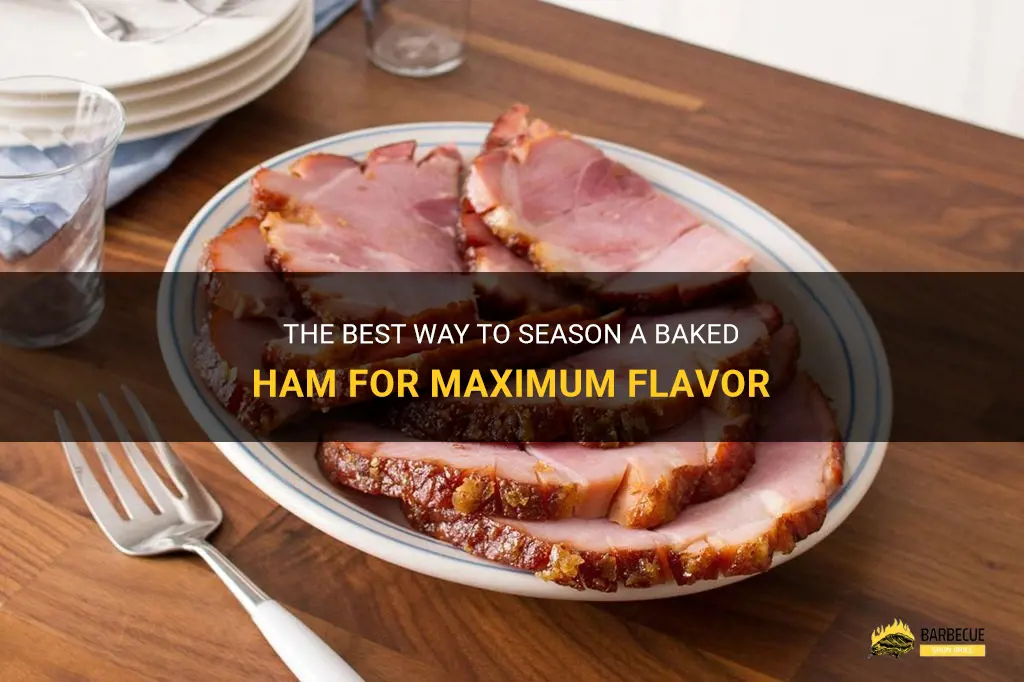
Nothing beats the mouthwatering aroma of a perfectly seasoned baked ham wafting through the house. Whether you're hosting a holiday feast or simply craving a deliciously flavorful main dish, seasoning your baked ham to perfection is the key to achieving a culinary masterpiece. From classic flavors like honey and mustard to tangy citrus and aromatic herbs, there's a seasoning combination out there to suit every taste bud. So, grab your apron and let's explore the art of seasoning a baked ham that will leave your dinner guests begging for seconds.
| Characteristics | Values |
|---|---|
| Type | Baked ham |
| Seasoning | Salt, pepper, herbs |
| Glaze | Honey, brown sugar, mustard, pineapple |
| Cooking Time | About 15 minutes per pound |
| Temperature | 325°F |
| Internal Temp | 145°F |
| Resting Time | 15-30 minutes |
| Slicing | Thin slices |
| Serving | Hot or cold |
What You'll Learn
- What are the best seasonings to use when seasoning a baked ham?
- Should the ham be seasoned before or after it is baked?
- Can I use a dry rub to season a baked ham?
- What is the best way to ensure the seasoning penetrates the meat during baking?
- Are there any specific techniques or tips for seasoning a baked ham to enhance its flavor?

What are the best seasonings to use when seasoning a baked ham?
When it comes to seasoning a baked ham, there are a few key ingredients that can really enhance the flavor and make your ham stand out. From classic pairings to unique combinations, the possibilities are endless. In this article, we will explore some of the best seasonings to use when seasoning a baked ham.
- Brown Sugar: One of the most popular seasonings for a baked ham is brown sugar. It adds a touch of sweetness and helps to create a beautiful caramelized crust on the outside of the ham. The sugar also balances out the saltiness of the ham, creating a harmonious flavor profile.
- Mustard: Mustard and ham are a classic pairing that never fails to impress. The tanginess of the mustard cuts through the richness of the ham, adding a delightful burst of flavor. Dijon mustard is particularly well-suited for this application.
- Pineapple: Pineapple and ham are a match made in heaven. The natural sweetness of the pineapple complements the smoky, salty flavors of the ham, creating a balanced and flavorful combination. You can use pineapple juice or canned pineapple slices to add this tropical twist to your baked ham.
- Cloves: Cloves are a traditional spice used to season hams. They have a warm, aromatic flavor that pairs perfectly with the savory taste of ham. You can stud the ham with whole cloves or use ground cloves in a glaze for a more intense flavor.
- Honey: For a touch of sweetness and a beautiful glaze, honey is an excellent choice. It adds a subtle floral flavor to the ham and helps to create a glossy, caramelized coating. Drizzle or brush honey over the ham during the last few minutes of baking.
- Garlic and Herbs: If you prefer a savory and aromatic flavor profile, garlic and herbs are a fantastic option. You can create a rub with minced garlic, dried herbs like thyme and rosemary, salt, and pepper. This will infuse the ham with a delicious aroma and add depth to the overall taste.
- Apple Cider: Apple cider can lend a fruity and slightly tangy flavor to your baked ham. You can use it as a marinade or incorporate it into a glaze for a unique twist. The natural sweetness of the apple cider pairs well with the saltiness of the ham.
- Orange Zest: Adding a touch of citrus to your ham can brighten up the flavors and add a pop of freshness. Use a zester to grate some orange zest onto the surface of the ham before baking. The vibrant aroma and tangy taste will take your baked ham to the next level.
When seasoning a baked ham, it's important to strike a balance between sweet, savory, and aromatic flavors. Feel free to experiment with different combinations of these seasonings to find your perfect flavor profile. Whether you prefer a classic brown sugar and mustard glaze or a more adventurous blend of pineapple and cloves, the key is to have fun and create a unique and delicious ham that will impress your guests.
The Ultimate Guide to Baking Fiesta Ham: Easy Steps for a Flavourful Dish
You may want to see also

Should the ham be seasoned before or after it is baked?
When preparing a ham, one of the most important considerations is when to season it. Some people believe that seasoning the ham before baking it allows the flavors to penetrate the meat more deeply, while others prefer to season it after baking to preserve the natural flavors. So, which approach is better? Let's explore the different perspectives and considerations.
The scientific perspective suggests that seasoning the ham before baking it can result in a more flavorful and evenly seasoned dish. When you season the ham before baking, the heat helps to activate and distribute the flavors throughout the meat. This allows the seasonings to penetrate deeper into the ham, resulting in a more flavorful and tasty final product.
On the other hand, some experienced cooks argue that seasoning the ham after it is baked is the way to go. They believe that by seasoning the ham after baking, you can better control the amount of seasoning and prevent it from overpowering the natural flavor of the meat. Additionally, seasoning the ham after baking allows you to adjust the flavors to your liking, as you can taste and add more seasonings if desired.
Whether you choose to season the ham before or after baking, it is important to follow a step-by-step process to ensure the best results. Here is a simple guide to seasoning a ham both before and after baking:
Seasoning before baking:
- Start by removing the packaging from the ham and pat it dry with paper towels.
- Rub the ham with your choice of seasonings, such as salt, pepper, garlic powder, or herbs. Be sure to coat all sides of the ham to ensure even seasoning.
- Place the seasoned ham in a baking dish or roasting pan, and cover it loosely with foil.
- Bake the ham according to the instructions, based on its weight. The internal temperature should reach 145°F.
- Once the ham is baked, let it rest for a few minutes before carving.
Seasoning after baking:
- Follow the steps above to prepare and bake the ham without seasoning it.
- Once the ham is fully cooked, remove it from the oven and let it rest for a few minutes.
- Thinly slice the ham and arrange the slices on a serving platter.
- Sprinkle the slices with your desired seasonings, such as salt, pepper, paprika, or glaze.
- Toss the slices gently to evenly distribute the seasonings, taking care not to break the slices.
- Serve the seasoned ham slices immediately.
It's important to note that personal preference plays a significant role in determining when to season a ham. Some individuals prefer to season it before baking to infuse the flavors into the meat, while others prefer to season it after baking to preserve the natural taste. Ultimately, the decision is up to you and depends on your desired outcome.
In conclusion, whether you choose to season your ham before or after baking, both approaches have their merits. The scientific perspective advocates for seasoning before baking to achieve a more evenly flavored and tender ham, while experience suggests seasoning after baking for better control over the flavors. By following the step-by-step guidelines, you can ensure a deliciously seasoned ham that will impress your guests at any gathering. Experiment and find the method that works best for your taste preferences, and enjoy the flavorful journey of making a perfectly seasoned ham.
Is Honey Baked Ham Delivery Available?
You may want to see also

Can I use a dry rub to season a baked ham?
Yes, you can definitely use a dry rub to season a baked ham. While traditionally, hams are often glazed with a sweet or savory sauce, using a dry rub can add a unique and delicious flavor to your ham.
A dry rub is a combination of herbs, spices, and seasonings that are rubbed onto the surface of the meat before cooking. It helps to enhance the natural flavors and adds depth to the overall taste of the ham.
Here is a step-by-step guide on how to use a dry rub to season a baked ham:
- Choose your dry rub: There are countless dry rub recipes available, with combinations of spices and herbs that cater to different flavor profiles. You can opt for a simple blend of salt, pepper, garlic powder, onion powder, and paprika, or get creative with other spices like cumin, thyme, or mustard powder. Experiment and find a combination that suits your taste.
- Prepare the ham: Before applying the dry rub, make sure the ham is properly prepared. It is recommended to trim off any excess fat and score the surface of the ham in a diamond pattern. This not only helps the flavors of the dry rub to penetrate the meat but also gives an attractive presentation.
- Apply the dry rub: Generously apply the dry rub to the surface of the ham, ensuring that it is evenly coated. Rub it in with your hands, pressing it firmly onto the meat. Make sure to cover all sides of the ham, including the top, bottom, and sides.
- Let it marinate: To allow the flavors of the dry rub to infuse into the ham, it is best to let it marinate for a few hours or even overnight. Wrap the ham tightly in plastic wrap or place it in a sealed container and refrigerate. This will also help to tenderize the meat and make it more flavorful.
- Bake the ham: When you are ready to cook the ham, preheat your oven to the desired temperature according to the recipe you are using. Place the ham on a baking dish or roasting pan, and cook it in the oven for the specified time. Make sure to check the internal temperature of the ham to ensure it is cooked to the appropriate doneness.
Before serving, allow the ham to rest for a few minutes to allow the juices to distribute evenly. Slice and serve with your preferred glaze or sauce, or enjoy it as is with the delicious flavors of the dry rub.
Using a dry rub to season a baked ham can elevate its taste and make it a standout dish. The combination of spices and herbs adds a flavorful crust to the ham, creating a satisfying experience for your taste buds. Whether you prefer a sweet or savory profile, there are endless possibilities when it comes to creating the perfect dry rub for your ham. So go ahead and experiment with different combinations to find your favorite flavor.
The Caloric Content of 1 oz of Baked Ham Revealed
You may want to see also

What is the best way to ensure the seasoning penetrates the meat during baking?
Baking meat is a popular cooking method that provides delicious and tender results. However, ensuring that the seasoning penetrates the meat can sometimes be a challenge. Properly seasoning the meat before baking not only adds flavor but also helps to tenderize the meat and enhance its overall taste. In this article, we will explore the best ways to ensure that the seasoning penetrates the meat during the baking process.
- Choose the right seasoning: The type of seasoning you choose plays a crucial role in how well it penetrates the meat. Rubs, marinades, and brines are all effective ways to season meat. Rubs are dry mixtures of herbs, spices, and salt that are massaged into the meat. Marinades are liquid mixtures typically made with oil, acid (such as vinegar or citrus juice), and various seasonings. Brines involve soaking the meat in a saltwater solution for an extended period. All three methods are effective at infusing flavor into the meat.
- Use a fork or a meat tenderizer: Before applying the seasoning, use a fork or a meat tenderizer to create small punctures in the meat. This will help the seasoning to penetrate deeper into the meat as it breaks down the muscle fibers. Be gentle but thorough when making these punctures to ensure even distribution of the seasoning.
- Allow for proper marinating or rubbing time: Depending on the size and thickness of the meat, you'll need to allow sufficient time for the seasoning to penetrate. Rubs can be applied immediately before baking, but allowing the meat to sit for a few hours in the refrigerator will enhance the flavor. Marinades usually require longer marinating times, ranging from a few hours to overnight. The longer the meat sits in the marinade, the more time the seasoning has to penetrate the meat. Brining can take several hours to overnight, depending on the size and type of meat.
- Consider the meat's texture: The texture of the meat can affect how well the seasoning penetrates. Tougher cuts of meat, such as roasts or steaks, may require more time for the seasoning to penetrate. Consider using a meat tenderizer or a marinade with acidic ingredients to help break down the muscle fibers and allow the seasoning to seep in.
- Apply seasoning evenly: To ensure even distribution of the seasoning, make sure to coat the meat thoroughly. Using your hands or a brush, massage the seasoning into the meat, making sure it reaches all areas. Pay special attention to crevices and hard-to-reach areas to achieve an evenly seasoned result.
- Allow the meat to rest: After applying the seasoning, allow the meat to rest at room temperature for about 30 minutes before baking. This step allows the seasoning to penetrate the meat further and helps to bring the meat to a more even temperature, resulting in more even cooking.
- Consider using a cooking method that encourages flavor absorption: Some cooking methods, such as braising or slow-cooking, can help the seasoning penetrate the meat more effectively. These methods involve cooking the meat in liquid over a long period, allowing the flavors to meld together and deeply penetrate the meat. Using a covered roasting pan or aluminum foil during baking can also help to trap the flavors and moisture, enhancing the seasoning penetration.
In conclusion, there are several ways to ensure that the seasoning penetrates the meat during baking. Using the right seasoning, creating small punctures in the meat, allowing for proper marinating or rubbing time, considering the meat's texture, applying the seasoning evenly, allowing the meat to rest, and using a cooking method that encourages flavor absorption are all effective techniques to enhance the seasoning penetration. Experiment with different methods and seasonings to find the one that best suits your taste preferences and cooking style. With some practice, you'll be able to achieve perfectly seasoned and flavorful baked meat every time.
The Caloric Content of Deli Virginia Baked Ham: Providing Insight into Its Nutritional Value
You may want to see also

Are there any specific techniques or tips for seasoning a baked ham to enhance its flavor?
Baked ham is a classic dish that is often enjoyed during holidays or special occasions. While cooking a ham may seem like a straightforward process, the way it is seasoned can greatly enhance its flavor. Here are some specific techniques and tips for seasoning a baked ham to ensure a delicious and flavorful result.
- Choose the right ham: The type of ham you choose can greatly affect its flavor. There are several types of hams available, such as bone-in, boneless, smoked, or cured hams. Each type has its own unique flavor profile, so it's important to choose a ham that suits your taste preferences.
- Score the ham: Before seasoning, score the surface of the ham with shallow cuts in a crisscross pattern. This will help the flavors penetrate the meat and also give the ham an attractive appearance. Be careful not to cut too deep, as you don't want to dry out the meat.
- Create a flavorful glaze: A glaze adds a sweet and savory coating to the ham, enhancing its taste. Create a glaze by combining ingredients like brown sugar, honey, mustard, maple syrup, or fruit preserves. Experiment with different combinations to find your favorite flavor. Apply the glaze onto the scored ham using a brush, ensuring it covers the entire surface.
- Insert cloves for aromatic flavor: Cloves are often used to add a warm and aromatic flavor to baked hams. After scoring the ham, you can insert whole cloves into the scored intersections for added flavor. Be judicious with the number of cloves, as their flavor can be potent.
- Use spices and herbs: Spices and herbs can lend a unique flavor to the ham. Common seasonings include garlic, onion powder, paprika, thyme, rosemary, or cinnamon. Combine these seasonings with salt and pepper, and rub the mixture onto the ham before baking. This will infuse the meat with a delicious aroma and flavor.
- Baste during cooking: As the ham bakes, it can dry out, so it's important to baste it periodically. Basting with the glaze or the pan juices will help keep the ham moist and add an extra layer of flavor. Use a basting brush or spoon to generously coat the surface of the ham throughout the cooking process.
- Add moisture: To prevent the ham from drying out, you can add some moisture to the baking dish. This can be done by placing a cup of water or broth in the bottom of the dish while the ham bakes. The moisture will create steam, keeping the ham juicy and tender.
- Consider a slow-cooking method: Another technique to enhance flavor is to cook the ham at a lower temperature for a longer period. Slow cooking allows the flavors to develop and penetrate the meat more thoroughly. This can result in a more tender and flavorful ham.
By following these techniques and tips, you can elevate the flavor of your baked ham and create an irresistible dish that is sure to impress. Whether you're cooking for a holiday feast or a special occasion, a well-seasoned ham is the centerpiece that will leave your guests wanting more. Experiment with different seasonings and methods to find the perfect combination that suits your taste buds. Enjoy!
Baking a Perfectly Glazed Spiral Ham: A Step-by-Step Guide
You may want to see also







